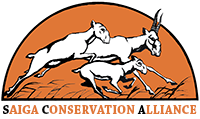Recently, a joint expedition of the Saiga Conservation Alliance and the Academy of Sciences of Uzbekistan to the former bottom of the Aral Sea – an inland sea that was lost through human actions, and which is known as one of the world’s worst man-made ecological disasters.
The purpose of the expedition was to study rare species of animals living on the territory of the former islands, on new land and in the coastal part of the Big Aral – a residual western reservoir located in Uzbekistan. Another and, perhaps, the most important task was to propose the territory for a new national park there. We visited various parts of the largest of the islands – Resurrection Island and the smaller one – the Lazarev Island, discovered Cape Sulam, and also discovered a site rich with the remains of ancient fossilized invertebrates that lived in the Aral Sea during the Mesozoic period.
The greatest joy for us was the discovery of a previously unknown group of saigas living on the hard-to-reach sands of Cape Sulam. Numerous fresh tracks testified to their recent presence in this area. We were very pleased to find areas where saigas had been using to rest and sleep as well as areas which signaled that calving that had taken place here, as well as the tracks and droppings of saiga calves. The sub-population is not large – 25-30 individuals, and it is clear that saigas are at the very peak of survival, since these sandy areas are not known to be their traditional habitats. Here, it is difficult to hunt antelope, as the terrain of the former sea-bed makes access difficult. Although, from September to March people can be seen here – collecting of brine shrimp, we suspect that they occasionally hunt saigas too.
From this newly discovered saiga residence it is just a stone’s throw to the shores of the Aral Sea, where we saw large flocks of flamingos (over 400 birds), glossy ibis, various species of ducks, sandpipers, and gulls. Of course, Sulam should be included, along with Resurrection and Lazarev Island (where we also noted fresh saiga tracks), into the territory of the future protected area, which we plan to create with the support of our Whitley Fund for Nature award “Resurrection Island: securing biodiversity restoration through multi-scale economic development in Uzbekistan”.

Fresh saigas footprints on Sulam Cape


A team of researchers from SCA and the Academy of Sciences of the Republic of Uzbekistan (Uzbekistan and Karakalpakstan) / Команда исследователей SCA и Академии наук РУз (Узбекистан и Каракалпакстан)

Birdwatchers 
Flock of Flamingos flock, Sulama Cape / Стая фламинго. Мыс Сулама 
Stilt waders, Sulam Cape / Кулики-ходулочники. Мыс Сулама

Остров Возрождения: найдена новая локация обитании сайгаков на Аральском море
На днях закончилась совместная экспедиция Альянса по сохранению сайгака и Академии Наук Узбекистана на бывшее дно Аральского моря –погибшее по вине человека море и сейчас больше известное как зона экологического кризиса и печальный урок человечеству как делать нельзя. Целью экспедиции было изучение редких видов животных, обитающих на территории бывших островов, на новой суше и в прибрежной часть Большого Арала – остаточного западного водоема, расположенного на территории Узбекистана. Еще одной и, пожалуй, наиболее важной задачей было сделать выбор территории для создания там национального парка. Мы посетили различные участки самого большого из островов – острова Возрождения, более мелкого – острова Лазарева, открыли для себя мыс Сулама, а также обнаружили участок богатый останками древних окаменевших беспозвоночных, населявших древнее море на месте современного Арала в мезозойский период. Но самой большой для нас радостью было обнаружение не известной ранее группировки сайгаков, обитающих в труднодоступных песках мыса Сулама. Многочисленные свежие следы свидетельствовали об их постоянном пребывании в этом месте. Нас очень порадовали свежие лежки, свидетельствующие о прошедшем здесь окоте, а также следы и помет сайгачат. Численность суб-популяции не велика – 25-30 особей, и ясно что сайгаки находятся на самом пике выживания, так как закрепленные пески – это не традиционные для них местообитания. Но именно здесь сложно охотиться на антилоп, и сами по себе места труднодоступные. Хотя с сентября по март здесь появляются люди – сборщики рачка артемии. И у нас есть подозрение что они от случая к случаю охотятся на сайгаков. От дома сайгаков уже рукой подать до берега Аральского моря, где мы наблюдали большие стаи фламинго (свыше 400 птиц), каравайки, разные виды уток, куликов и чаек. Безусловно Сулама должна быть включена наряду с Возрождением и островом Лазарева (где мы также отметили свежие следы сайгаков) в будующую ООПТ, которую мы планируем создать при поддержке проекта WFN «Resurrection Island: securing biodiversity restoration through multi-scale economic development in Uzbekistan».
